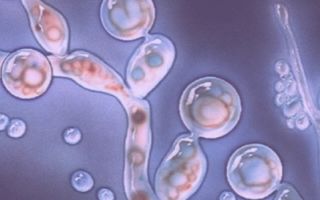Intestinal candidiasis (candimycosis) is a disease caused by yeast-like fungi Candida spp.
Content
Development of the disease
Candidiasis of the mucous membranes of the digestive organs is one of the most common fungal infections. What causes candidiasis to appear in the body?
The mucous membranes of our body are constantly in contact with the environment. Candida fungus is widespread in nature and is found in soil, water, food, and on household surfaces.
For example, in dairy products, when inoculating samples, Candida was detected in 75% of sour cream samples, 66% of cottage cheese, 35% of kefir, 12-20% of milk (we are talking about dairy products with an unexpired shelf life).
This indicates that contact of mucous membranes with this fungus is common. A large number of people are carriers of candida. For example, Candida fungi are found in stool in 65-80% of the population of European countries.
There are three stages of infection with these fungi:
- candidacy,
- intestinal dysbiosis with overgrowth of Candida,
- candidal colitis.
Causes of candidiasis
As noted above, a large part of the population is Candida carriers due to daily contact with them.
The fungus is opportunistic. It begins its pathogenic effect on the body when such unfavorable factors appear as:
- taking antibiotics, corticosteroids, other antibacterial drugs,
- weakened immune system
- acute intestinal infections.
Against their background, the activity of “beneficial” microflora is suppressed and excessive growth of candida begins, which leads to candidiasis dysbiosis. It develops more often in children and the elderly.
The third stage, candidal colitis, develops when the fungus transforms into pseudomycelium, when it begins to affect the intestinal tissue.
Yeast-like fungi initially damage the mucous membrane of the colon, forming pseudomembranous plaques on it. Subsequently, as it penetrates into the submucosa, an infection phase is possible with the formation of lesions in the internal organs.
This stage of the disease, as a rule, develops in people suffering from diseases, the treatment of which or the diseases themselves sharply reduce immunity and damage the intestinal microflora. These include:
- leukemia, tumors after intensive cytostatic polychemotherapy, immunosuppressive or radiation therapy,
- AIDS,
- insulin-dependent diabetes mellitus,
- nonspecific ulcerative colitis.
Symptoms
Candidiasis does not cause any symptoms and is considered normal.
Dysbiosis with excessive growth of candida is characterized by symptoms of dyspepsia:
- nausea,
- stomach ache,
- bloating,
- stool disorder,
- skin rash,
- sometimes inflammation of the nasopharynx and genitals.
Obesity and rapid weight gain may also indicate candidiasis.
As the disease develops, an admixture of blood and pus appears in the stool, body temperature rises, and when it enters the third stage, the liver, lungs and other organs may be affected.
Some patients with intestinal candidiasis report the phenomenon of perianal candidiasis. It is characterized by persistently recurrent anal itching and burning. Upon examination, the doctor reveals redness and maceration around the anus, sharply demarcated from the surrounding skin, as well as peeling, superficial cracks and erosions.
Diagnostics
When making a diagnosis, it is important to distinguish candidiasis from candidiasis.
Thus, the detection of the growth of Candida fungus in a stool analysis is not a sufficient basis for confirming the diagnosis.
A combination of three factors may indicate dysbiosis with excessive growth of Candida fungi:
- symptoms of intestinal dyspepsia,
- laboratory confirmed deficiency of obligate (“useful”) intestinal bacteriobiota,
- growth of Candida fungi over 1000 CFU/g when stool cultured.
With candidal colitis, the diagnosis is helped by endoscopic and histological examination of the gastrointestinal tract.
On the mucous membrane, growths in the form of dense plaques of yellowish-brown color, tightly fused to the surface of the intestine, may be visible.
The diagnosis of perianal candidiasis is confirmed by the detection of pseudomycelium of candida during microscopic examination of the skin scales of the anal area.
Differential diagnosis of intestinal candidiasis is carried out with
Treatment
A modern antifungal drug is Diflucan.
Antifungal antibiotics are used: nystatin, levorin, amphotericin, amphoglucamine, mycoheptin, pimafucin. The drugs are prescribed orally for 10-14 days.
For septic complications, amphotericin B is used intravenously.
Foods for candidiasis
Proper nutrition can significantly improve your recovery prognosis.
If you suspect a disease, you should exclude all foods that contribute to the development of candida in the intestines - these are flour and sweet foods.
The second group of food products helps to destroy the fungus - garlic, onions, pumpkin seeds, vegetable oil.
The third group helps restore “beneficial” bacteria - lactic acid products and apples.
Forecast
The prognosis for intestinal candidiasis depends on the stage of development of the disease, timeliness of diagnosis and treatment. In most patients, it is aggravated by the presence of severe concomitant diseases.







